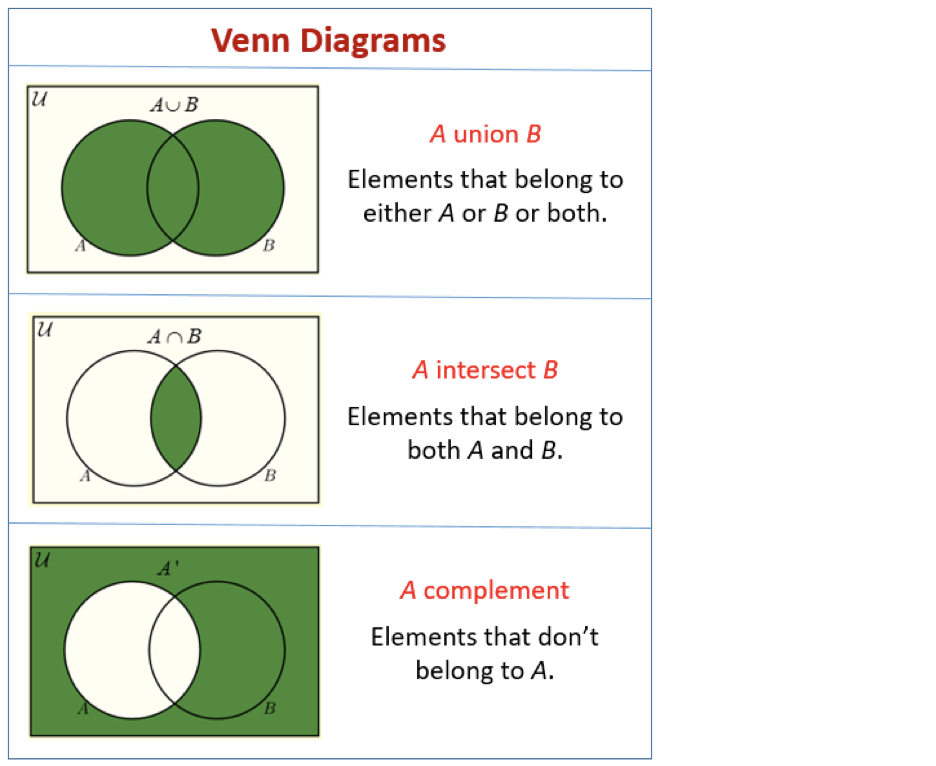1.10 Sets
Set theory is a fundamental branch of mathematics that deals with collections of objects, called sets. These objects are called elements or members of the set.Key Concepts:
-
Union of Sets:
The union of two sets \(A\) and \(B\), denoted by \(A \cup B\), is the set of elements that are in \(A\), in \(B\), or in both. \[ A \cup B = \{x \mid x \in A \text{ or } x \in B\}. \] -
Intersection of Sets:
The intersection of two sets \(A\) and \(B\), denoted by \(A \cap B\), is the set of elements that are in both \(A\) and \(B\). \[ A \cap B = \{x \mid x \in A \text{ and } x \in B\}. \] -
Complement of a Set:
The complement of a set \(A\), denoted by \(A'\), is the set of elements not in \(A\) but in the universal set \(U\). \[ A' = \{x \in U \mid x \notin A\}. \] -
Universal Set:
The universal set, denoted by \(U\), is the set that contains all elements under consideration in a particular context. All subsets are defined within this universal set. -
Cardinality of a Set:
The cardinality of a set \(A\), denoted by \(|A|\), is the number of elements in the set. -
Venn Diagrams:
Venn diagrams are visual representations of sets and their relationships, such as union, intersection, and complement.

Example 1: Union of Two Sets
Given \(A = \{1, 2, 3, 4\}\) and \(B = \{3, 4, 5, 6\}\), find \(A \cup B\).Solution:
Step 1: Combine all unique elements of \(A\) and \(B\): \[ A \cup B = \{1, 2, 3, 4, 5, 6\}. \] Therefore, \(A \cup B = \{1, 2, 3, 4, 5, 6\}\).Example 2: Intersection of Two Sets
Given \(A = \{1, 2, 3, 4\}\) and \(B = \{3, 4, 5, 6\}\), find \(A \cap B\).Solution:
Step 1: Identify the common elements in \(A\) and \(B\): \[ A \cap B = \{3, 4\}. \] Therefore, \(A \cap B = \{3, 4\}\).Example 3: Complement of a Set
Given \(U = \{1, 2, 3, 4, 5, 6, 7\}\) and \(A = \{2, 4, 6\}\), find \(A'\).Solution:
Step 1: List all elements in \(U\) that are not in \(A\): \[ A' = \{1, 3, 5, 7\}. \] Therefore, \(A' = \{1, 3, 5, 7\}\).Example 4: Cardinality of Sets and Venn Diagram Application
In a survey, 20 students like basketball, 15 like football, and 10 like both sports. How many students like at least one of the two sports?Solution:
Step 1: Use the principle of inclusion-exclusion: \[ |A \cup B| = |A| + |B| - |A \cap B|. \] Step 2: Substitute the values: \[ |A \cup B| = 20 + 15 - 10 = 25. \] Therefore, 25 students like at least one of the two sports.